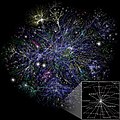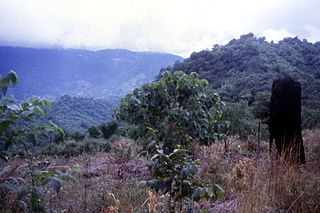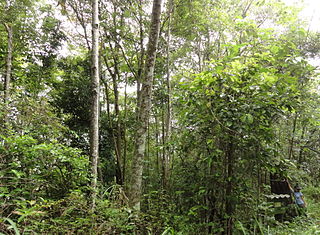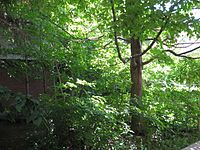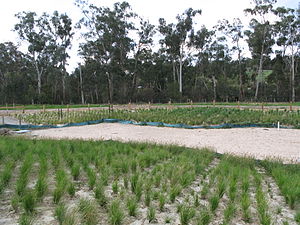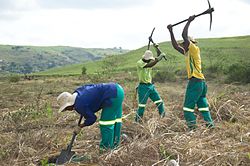Information can be thought of as the resolution of uncertainty;
it is that which answers the question of "what an entity is" and thus
defines both its essence and nature of its characteristics. It is
associated with data, as data represents values attributed to parameters, and information is data in context and with meaning attached. Information relates also to knowledge, as knowledge signifies understanding of an abstract or concrete concept.
In terms of communication, information is expressed either as the content of a message or through direct or indirect observation. That which is perceived can be construed as a message in its own right, and in that sense, information is always conveyed as the content of a message.
Information can be encoded into various forms for transmission and interpretation (for example, information may be encoded into a sequence of signs, or transmitted via a signal). It can also be encrypted for safe storage and communication.
The uncertainty of an event is measured by its probability of
occurrence and is inversely proportional to that. The more uncertain an
event, the more information is required to resolve uncertainty of that
event. The bit is a typical unit of information, but other units such as the nat may be used. For example, the information encoded in one "fair" coin flip is log2(2/1) = 1 bit, and in two fair coin flips is
log2(4/1) = 2 bits.
The concept of information has different meanings in different contexts. Thus the concept becomes related to notions of constraint, communication, control, data, form, education, knowledge, meaning, understanding, mental stimuli, pattern, perception, representation, and entropy.
Etymology
The English word apparently derives from the Latin stem (information-) of the nominative (informatio): this noun derives from the verb informare (to inform) in the sense of "to give form to the mind", "to discipline", "instruct", "teach". Inform itself comes (via French informer) from the Latin verb informare, which means to give form, or to form an idea of. Furthermore, Latin itself already contained the word informatio meaning concept or idea, but the extent to which this may have influenced the development of the word information in English is not clear.
The ancient Greek word for form was μορφή (morphe; cf. morph) and also εἶδος (eidos) "kind, idea, shape, set", the latter word was famously used in a technical philosophical sense by Plato (and later Aristotle) to denote the ideal identity or essence of something (see Theory of Forms). 'Eidos' can also be associated with thought, proposition, or even concept.
The ancient Greek word for information is πληροφορία, which transliterates (plērophoria) from
πλήρης (plērēs) "fully" and φέρω (phorein) frequentative of (pherein) to carry through. It literally means "bears fully" or "conveys fully". In modern Greek the word Πληροφορία is still in daily use and has the same meaning as the word information in English. In addition to its primary meaning, the word Πληροφορία as a symbol has deep roots in Aristotle's semiotic triangle. In this regard it can be interpreted to communicate information to the one decoding that specific type of sign.
This is something that occurs frequently with the etymology of many
words in ancient and modern Greek where there is a very strong denotative
relationship between the signifier, e.g. the word symbol that conveys a
specific encoded interpretation, and the signified, e.g. a concept
whose meaning the interpreter attempts to decode.
In English, “information” is an uncountable mass noun.
Information theory approach
In information theory, information is taken as an ordered sequence of symbols
from an alphabet, say an input alphabet χ, and an output alphabet ϒ.
Information processing consists of an input-output function that maps
any input sequence from χ into an output sequence from ϒ. The mapping
may be probabilistic or deterministic. It may have memory or be
memoryless.
As sensory input
Often information can be viewed as a type of input to an organism or system. Inputs are of two kinds; some inputs are important to the function of the organism (for example, food) or system (energy) by themselves. In his book Sensory Ecology
Dusenbery called these causal inputs. Other inputs (information) are
important only because they are associated with causal inputs and can be
used to predict
the occurrence of a causal input at a later time (and perhaps another
place). Some information is important because of association with other
information but eventually there must be a connection to a causal input.
In practice, information is usually carried by weak stimuli that must
be detected by specialized sensory systems and amplified by energy
inputs before they can be functional to the organism or system. For
example, light is mainly (but not only, e.g. plants can grow in the
direction of the lightsource) a causal input to plants but for animals
it only provides information. The colored light reflected from a flower
is too weak to do much photosynthetic work but the visual system of the
bee detects it and the bee's nervous system uses the information to
guide the bee to the flower, where the bee often finds nectar or pollen,
which are causal inputs, serving a nutritional function.
As representation and complexity
The cognitive scientist
and applied mathematician Ronaldo Vigo argues that information is a
concept that requires at least two related entities to make quantitative
sense. These are, any dimensionally defined category of objects S, and
any of its subsets R. R, in essence, is a representation of S, or, in
other words, conveys representational (and hence, conceptual)
information about S. Vigo then defines the amount of information that R
conveys about S as the rate of change in the complexity
of S whenever the objects in R are removed from S. Under "Vigo
information", pattern, invariance, complexity, representation, and
information—five fundamental constructs of universal science—are unified
under a novel mathematical framework. Among other things, the framework aims to overcome the limitations of Shannon-Weaver information when attempting to characterize and measure subjective information.
As an influence that leads to transformation
Information is any type of pattern that influences the formation or transformation of other patterns. In this sense, there is no need for a conscious mind to perceive, much less appreciate, the pattern. Consider, for example, DNA. The sequence of nucleotides
is a pattern that influences the formation and development of an
organism without any need for a conscious mind. One might argue though
that for a human to consciously define a pattern, for example a
nucleotide, naturally involves conscious information processing.
Systems theory
at times seems to refer to information in this sense, assuming
information does not necessarily involve any conscious mind, and
patterns circulating (due to feedback)
in the system can be called information. In other words, it can be said
that information in this sense is something potentially perceived as
representation, though not created or presented for that purpose. For
example, Gregory Bateson defines "information" as a "difference that makes a difference".
If, however, the premise of "influence" implies that information
has been perceived by a conscious mind and also interpreted by it, the
specific context associated with this interpretation may cause the
transformation of the information into knowledge.
Complex definitions of both "information" and "knowledge" make such
semantic and logical analysis difficult, but the condition of
"transformation" is an important point in the study of information as it
relates to knowledge, especially in the business discipline of knowledge management. In this practice, tools and processes are used to assist a knowledge worker in performing research and making decisions, including steps such as:
- Review information to effectively derive value and meaning
- Reference metadata if available
- Establish relevant context, often from many possible contexts
- Derive new knowledge from the information
- Make decisions or recommendations from the resulting knowledge
Stewart (2001) argues that transformation of information into knowledge is critical, lying at the core of value creation and competitive advantage for the modern enterprise.
The Danish Dictionary of Information Terms
argues that information only provides an answer to a posed question.
Whether the answer provides knowledge depends on the informed person. So
a generalized definition of the concept should be: "Information" = An
answer to a specific question".
When Marshall McLuhan speaks of media and their effects on human cultures, he refers to the structure of artifacts that in turn shape our behaviors and mindsets. Also, pheromones are often said to be "information" in this sense.
As a property in physics
Information has a well-defined meaning in physics. In 2003 J. D. Bekenstein claimed that a growing trend in physics was to define the physical world as being made up of information itself (and thus information is defined in this way) (see Digital physics). Examples of this include the phenomenon of quantum entanglement,
where particles can interact without reference to their separation or
the speed of light. Material information itself cannot travel faster
than light even if that information is transmitted indirectly. This
could lead to all attempts at physically observing a particle with an
"entangled" relationship to another being slowed down, even though the
particles are not connected in any other way other than by the
information they carry.
The mathematical universe hypothesis
suggests a new paradigm, in which virtually everything, from particles
and fields, through biological entities and consciousness, to the multiverse itself, could be described by mathematical patterns of information. By the same token, the cosmic void
can be conceived of as the absence of material information in space
(setting aside the virtual particles that pop in and out of existence
due to quantum fluctuations, as well as the gravitational field and the
dark energy). Nothingness can be understood then as that within which no
matter, energy, space, time, or any other type of information could
exist, which would be possible if symmetry and structure break within
the manifold of the multiverse (i.e. the manifold would have tears or
holes). Physical information exists beyond event horizons, since
astronomical observations show that, due to the expansion of the universe, distant objects continue to pass the cosmological horizon, as seen from a present time, local observer point of view.
Another link is demonstrated by the Maxwell's demon thought experiment. In this experiment, a direct relationship between information and another physical property, entropy,
is demonstrated. A consequence is that it is impossible to destroy
information without increasing the entropy of a system; in practical
terms this often means generating heat. Another more philosophical
outcome is that information could be thought of as interchangeable with energy. Toyabe et al. experimentally showed in nature that information can be converted into work. Thus, in the study of logic gates, the theoretical lower bound of thermal energy released by an AND gate is higher than for the NOT gate (because information is destroyed in an AND gate and simply converted in a NOT gate). Physical information is of particular importance in the theory of quantum computers.
In thermodynamics, information is any kind of event that affects the state of a dynamic system that can interpret the information.
The application of information study
The information cycle (addressed as a whole or in its distinct components) is of great concern to information technology, information systems, as well as information science. These fields deal with those processes and techniques pertaining to information capture (through sensors) and generation (through computation, formulation or composition), processing (including encoding, encryption, compression, packaging), transmission (including all telecommunication methods), presentation (including visualization / display methods), storage (such as magnetic or optical, including holographic methods), etc.
Information visualization (shortened as InfoVis) depends on the computation and digital representation of data, and assists users in pattern recognition and anomaly detection.
Information security
(shortened as InfoSec) is the ongoing process of exercising due
diligence to protect information, and information systems, from
unauthorized access, use, disclosure, destruction, modification,
disruption or distribution, through algorithms and procedures focused on
monitoring and detection, as well as incident response and repair.
Information analysis
is the process of inspecting, transforming, and modelling information,
by converting raw data into actionable knowledge, in support of the
decision-making process.
Information quality
(shortened as InfoQ) is the potential of a dataset to achieve a
specific (scientific or practical) goal using a given empirical analysis
method.
Information communication represents the convergence of informatics, telecommunication and audio-visual media & content.
Technologically mediated information
It is estimated that the world's technological capacity to store information grew from 2.6 (optimally compressed) exabytes in 1986 – which is the informational equivalent to less than one 730-MB CD-ROM per person (539 MB per person) – to 295 (optimally compressed) exabytes in 2007. This is the informational equivalent of almost 61 CD-ROM per person in 2007.
The world’s combined technological capacity to receive information through one-way broadcast networks was the informational equivalent of 174 newspapers per person per day in 2007.
The world's combined effective capacity to exchange information through two-way telecommunication networks was the informational equivalent of 6 newspapers per person per day in 2007.
As of 2007, an estimated 90% of all new information is digital, mostly stored on hard drives.
As records
Records
are specialized forms of information. Essentially, records are
information produced consciously or as by-products of business
activities or transactions and retained because of their value.
Primarily, their value is as evidence of the activities of the
organization but they may also be retained for their informational
value. Sound records management ensures that the integrity of records is preserved for as long as they are required.
The international standard on records management, ISO 15489,
defines records as "information created, received, and maintained as
evidence and information by an organization or person, in pursuance of
legal obligations or in the transaction of business".
The International Committee on Archives (ICA) Committee on electronic
records defined a record as, "recorded information produced or received
in the initiation, conduct or completion of an institutional or
individual activity and that comprises content, context and structure
sufficient to provide evidence of the activity".
Records may be maintained to retain corporate memory
of the organization or to meet legal, fiscal or accountability
requirements imposed on the organization. Willis expressed the view that
sound management of business records and information delivered "...six
key requirements for good corporate governance...transparency;
accountability; due process; compliance; meeting statutory and common
law requirements; and security of personal and corporate information."
Semiotics
Michael Buckland
has classified "information" in terms of its uses: "information as
process", "information as knowledge", and "information as thing".
Beynon-Davies
explains the multi-faceted concept of information in terms of signs and
signal-sign systems. Signs themselves can be considered in terms of
four inter-dependent levels, layers or branches of semiotics:
pragmatics, semantics, syntax, and empirics. These four layers serve to
connect the social world on the one hand with the physical or technical
world on the other.
Pragmatics
is concerned with the purpose of communication. Pragmatics links the
issue of signs with the context within which signs are used. The focus
of pragmatics is on the intentions of living agents underlying
communicative behaviour. In other words, pragmatics link language to
action.
Semantics
is concerned with the meaning of a message conveyed in a communicative
act. Semantics considers the content of communication. Semantics is the
study of the meaning of signs - the association between signs and
behaviour. Semantics can be considered as the study of the link between
symbols and their referents or concepts – particularly the way that
signs relate to human behavior.
Syntax
is concerned with the formalism used to represent a message. Syntax as
an area studies the form of communication in terms of the logic and
grammar of sign systems. Syntax is devoted to the study of the form
rather than the content of signs and sign-systems.
Nielsen (2008) discusses the relationship between semiotics and
information in relation to dictionaries. He introduces the concept of lexicographic information costs
and refers to the effort a user of a dictionary must make to first
find, and then understand data so that they can generate information.
Communication normally exists within the context of some social
situation. The social situation sets the context for the intentions
conveyed (pragmatics) and the form of communication. In a communicative
situation intentions are expressed through messages that comprise
collections of inter-related signs taken from a language mutually
understood by the agents involved in the communication. Mutual
understanding implies that agents involved understand the chosen
language in terms of its agreed syntax (syntactics) and semantics. The
sender codes the message in the language and sends the message as
signals along some communication channel (empirics). The chosen
communication channel has inherent properties that determine outcomes
such as the speed at which communication can take place, and over what
distance.

